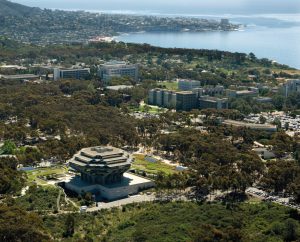
Where the hell did this crazy place come from?
One of the most pressing topics in Science Studies is colonial “world-making.” We seek to understand how the technoscientific world that surrounds us came into being. How is it that we came to dwell among these kinds of laboratories, hospitals, communication technologies, and forms of transportation? What are the roots of modern university pedagogy? How – and for whom – is nature transformed over time? Understanding that science and technology have been pivotal to colonial expansion, science studies scholars have investigated the material processes by which European technologies and political systems came to dominate the globe, starting in the sixteenth century. We seek, above all, to understand and ameliorate the ongoing prejudices and inequities that are produced by this dominance.
UCSD is a fascinating site of colonial and scientific world-making. Founded in 1960 and mostly constructed out of flimsy reinforced concrete, it sits on a hill in La Jolla surrounded by the homes of billionaires. It overlooks the Pacific Ocean to the west and to the south the San Diego-Tijuana border, reputed to be the steepest economic precipice in the world. Its student body is predominantly Asian, while approximately 77% of its faculty is both white and male. Since the 2010 ‘Compton Cookout,’ a ghetto-themed party at a frathouse off campus, it has been rocked by the racial controversy that has erupted during Obama’s presidency at most elite American universities, with the interesting twist that the racist fraternity in question was a South Asian one. It has graduated the highest number of science fiction authors of any American university and houses the oldest Cognitive Science department in the world.
Our plan is to map the intellectual ecology of this place, showing how world-making unfolds in time through the material, epistemic, and textual practices of science. Our method constitutes a form of “radical cartography.” The word “radical” comes from the Latin for “root.” Applied to our mapmaking, it evokes both the historical dimension of our proposal – we will be mapping change through time – and the moral urgency that we bring to it – our belief that the decolonization of the university is urgently demanded by the lessons of history. Maps have often been used for the purposes of colonial world-making. Radical cartography summons the ghosts of those who were despised, excluded, and enslaved in the making of this world of ours, in order to help us bend the arc of our institutions towards racial justice.
We propose to construct an interactive digital map, consisting of two layers. The first layer, which defines the geographical extent of our inquiry, will consist of the 1769 map of the territory of the Kumeyaay Nation, stretching from Escondido to Ensenada along the coast, and extending inland to the Colorado River. The second layer will be the satellite map of the same area today. The U.S.-Mexico border bisects this territory almost exactly in half, and provides a most instructive example of colonial infrastructure. Both maps will feature the same series of icons denoting different themes: immigration, health and medicine, eugenics, treaties and borders, etc. Clicking on any of the icons will take you to a website narrating the colonial world-making of that particular area.
The idea is for UCSD artists, humanists, and social scientists to collaborate with the Kumeyaay Nation on deepening our historical, sociological, and spatial awareness of the area in which we work. By adding icons and stories to the map, we will come to understand how Kumeyaay land transformed into the modern technoscape – how one map turned into the other through time. We will be applying for money for graduate students and post-docs to work on the map, looking especially for young bilingual and bicultural scholars accustomed to crossing the borders that divide our world. The project will help build ties to Mexican and Native American local historians and will fit into the ‘Understanding Cultures and Addressing Disparities’ focus at UCSD.